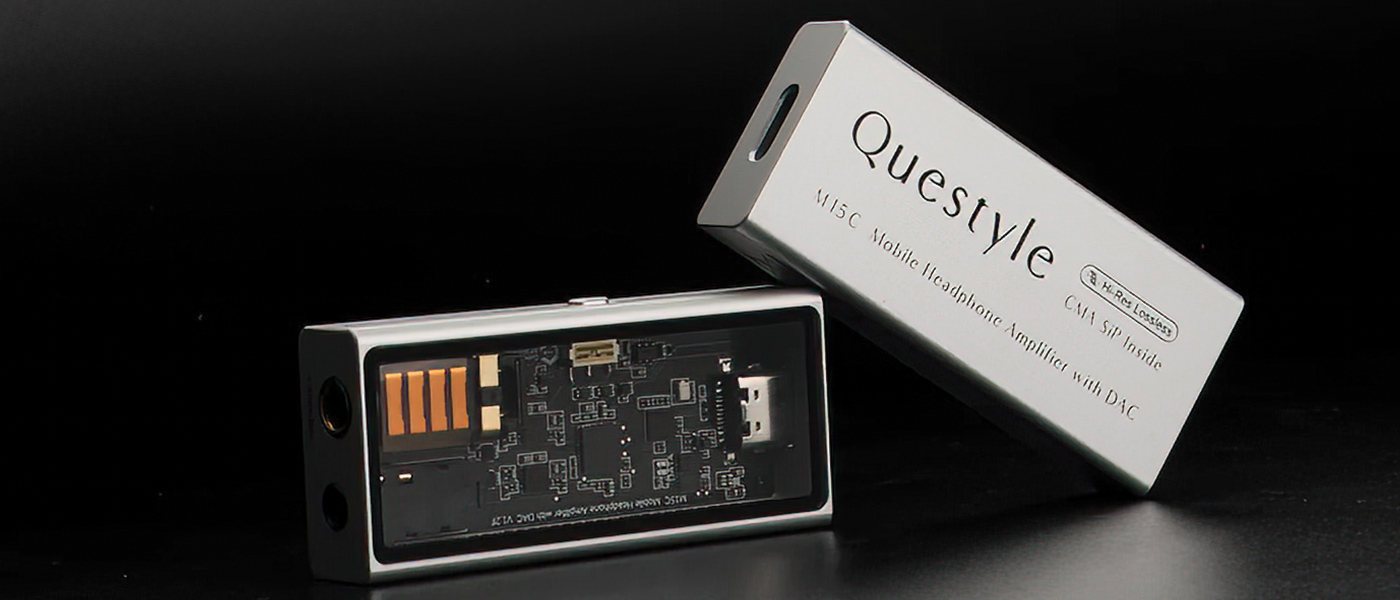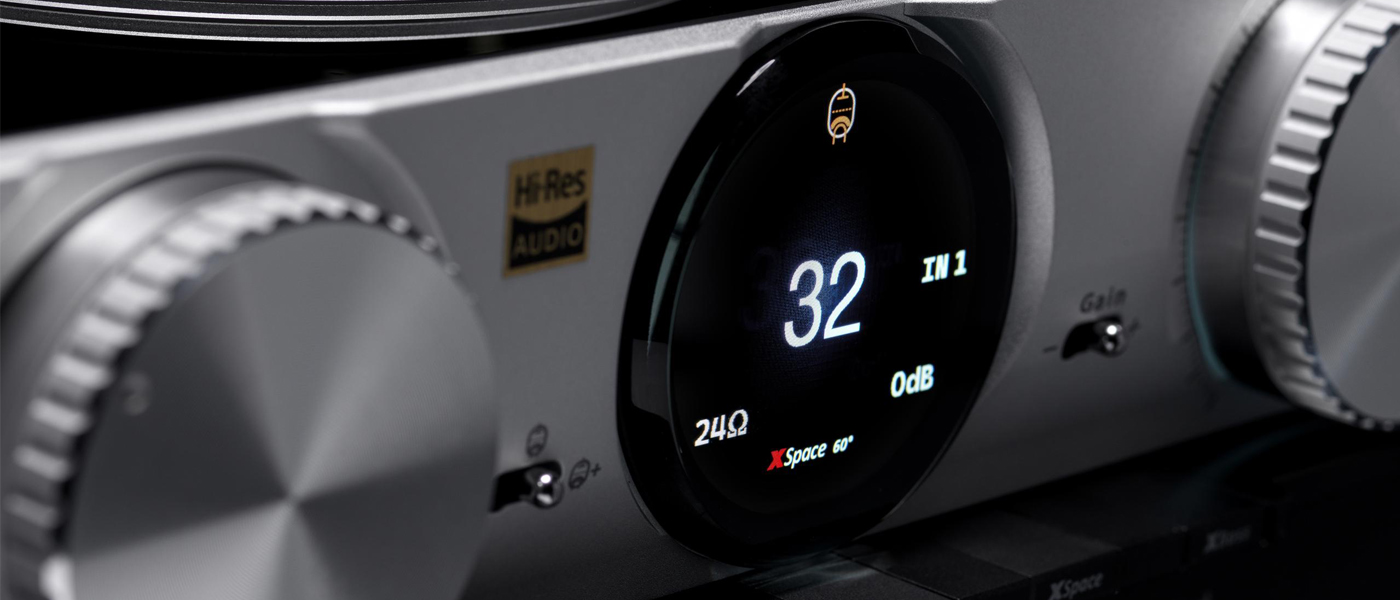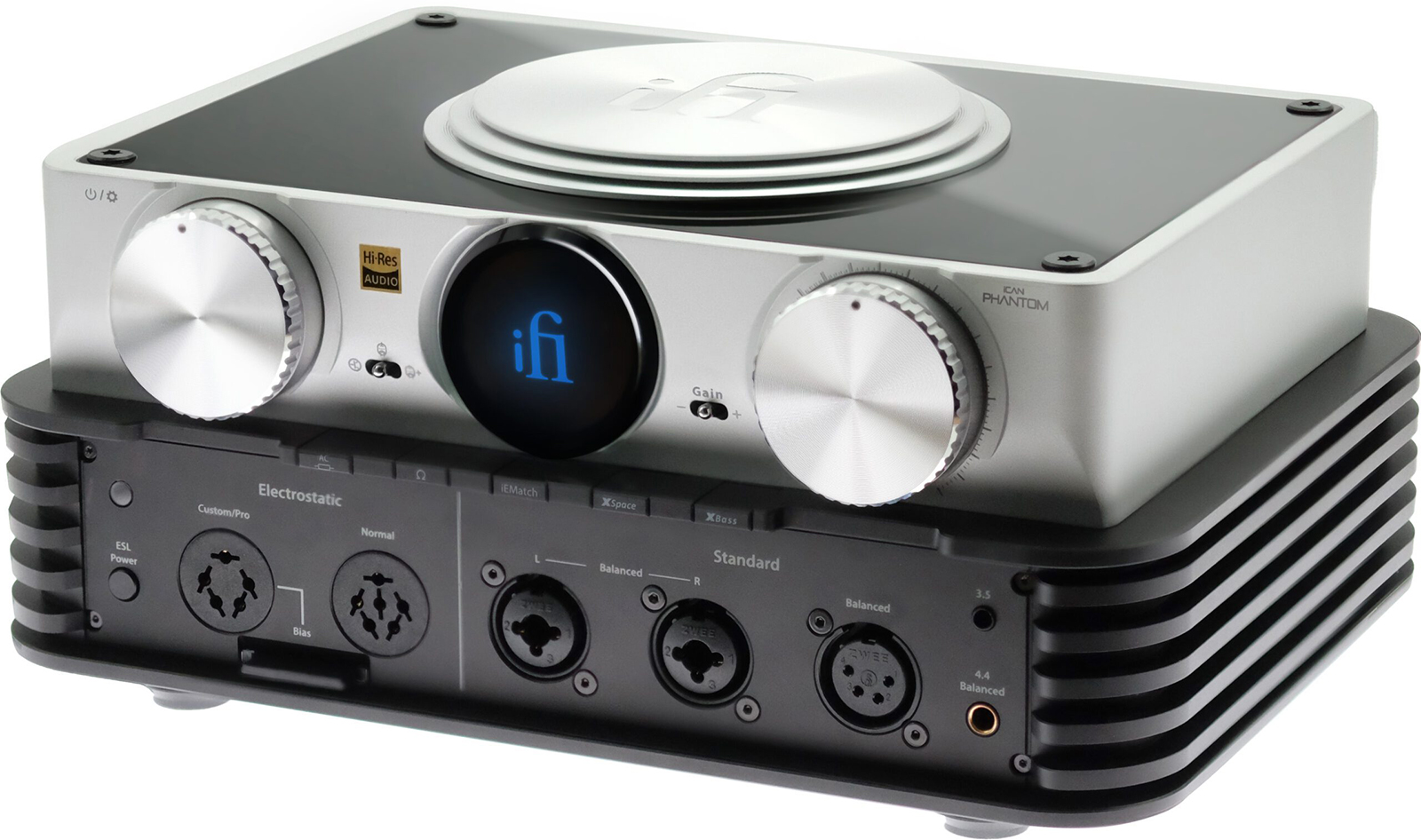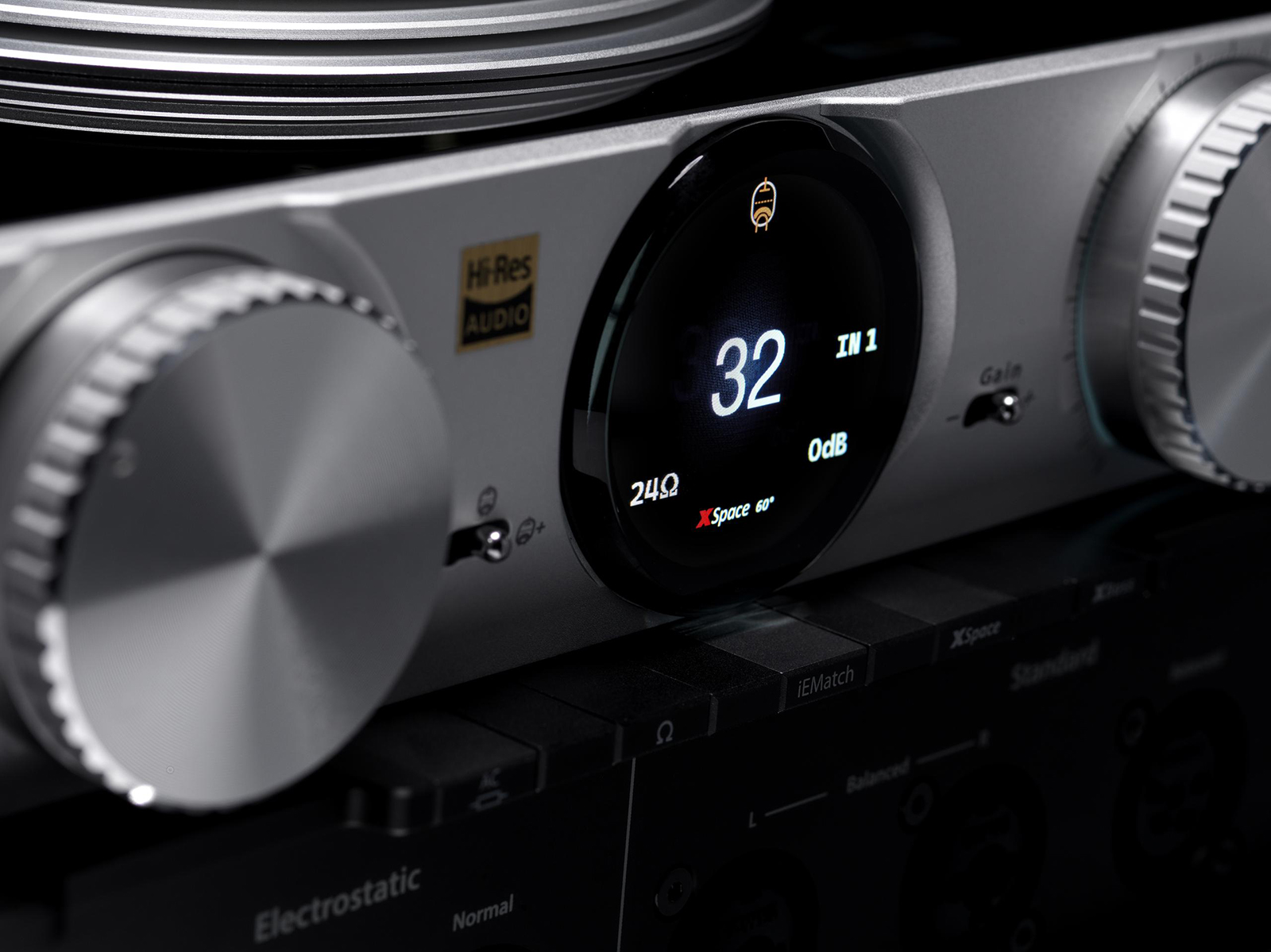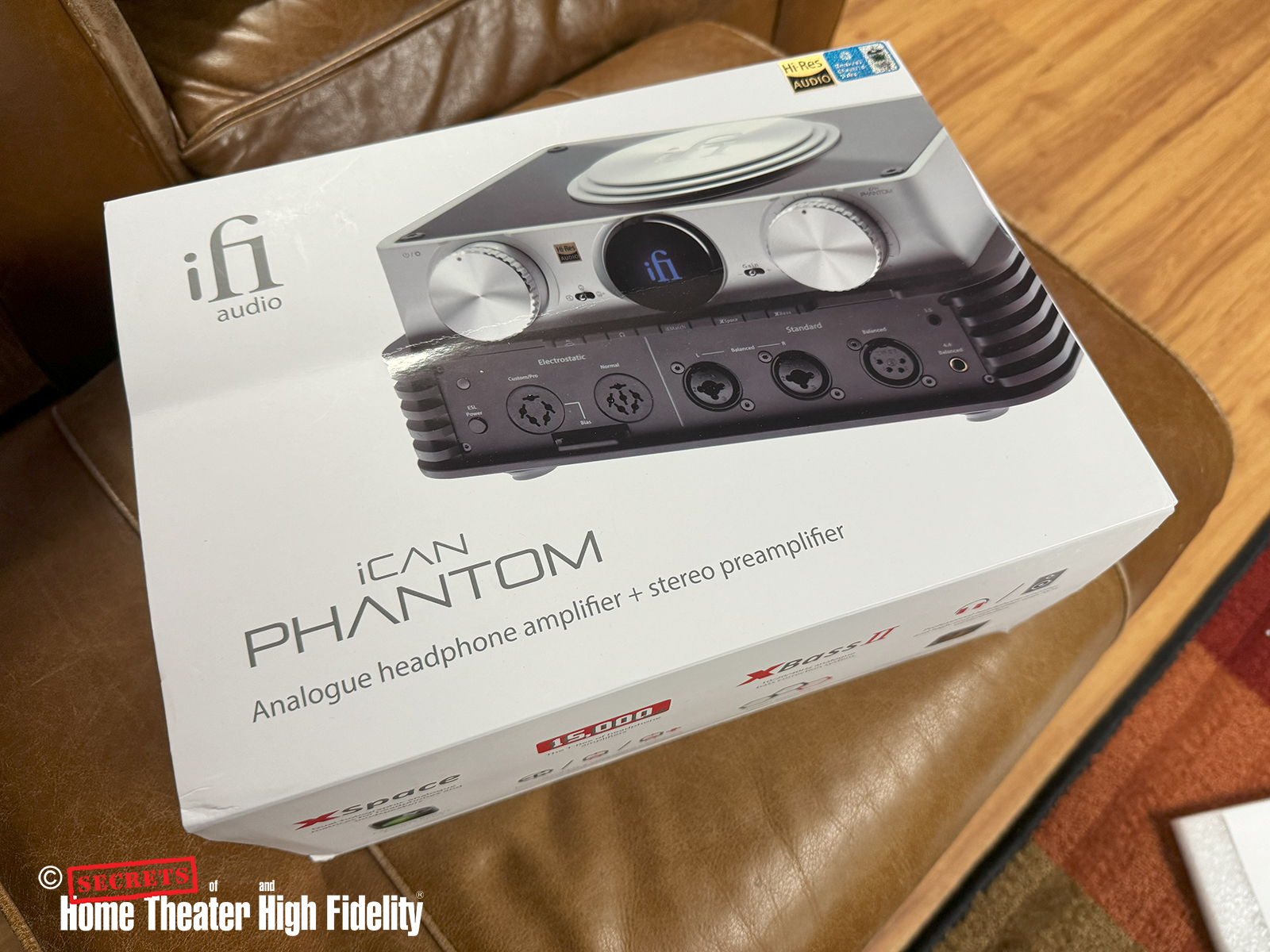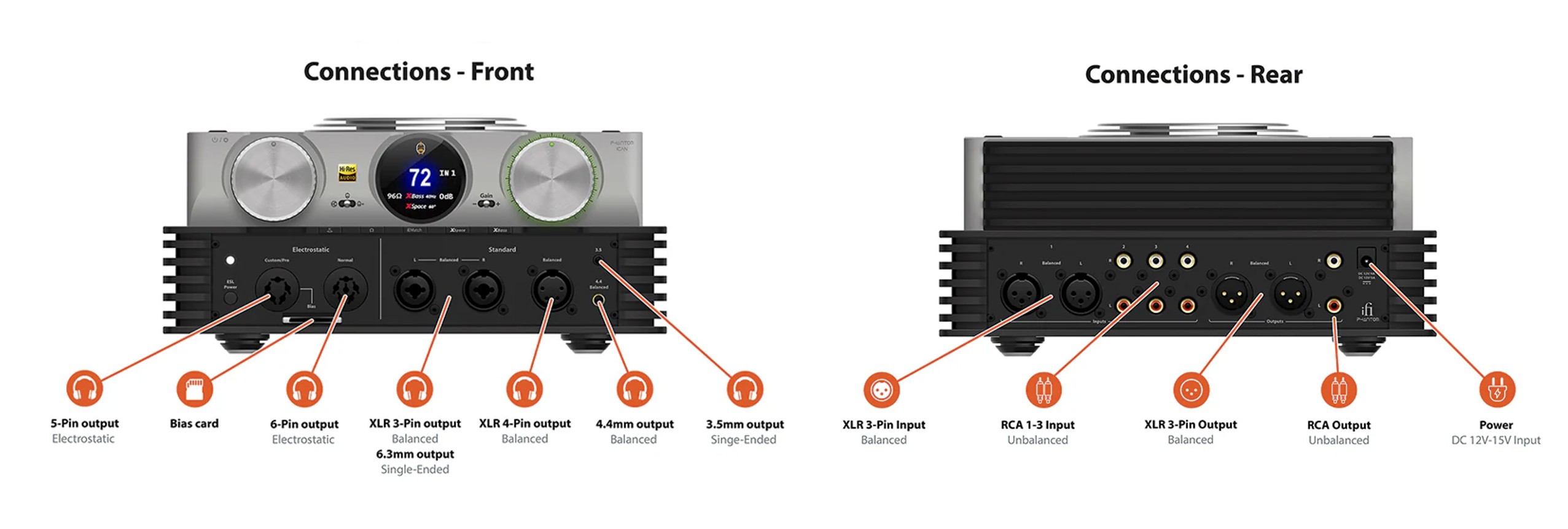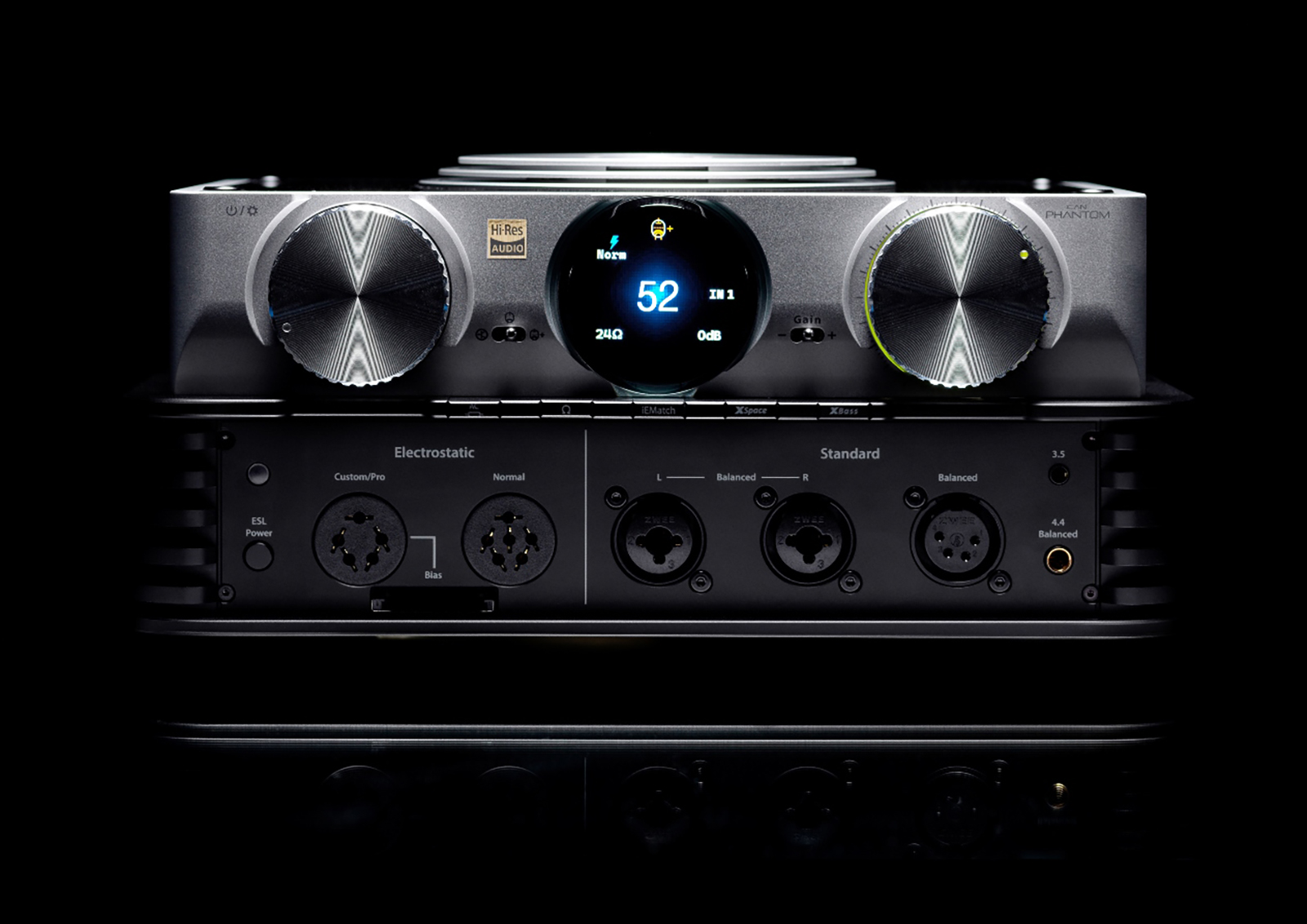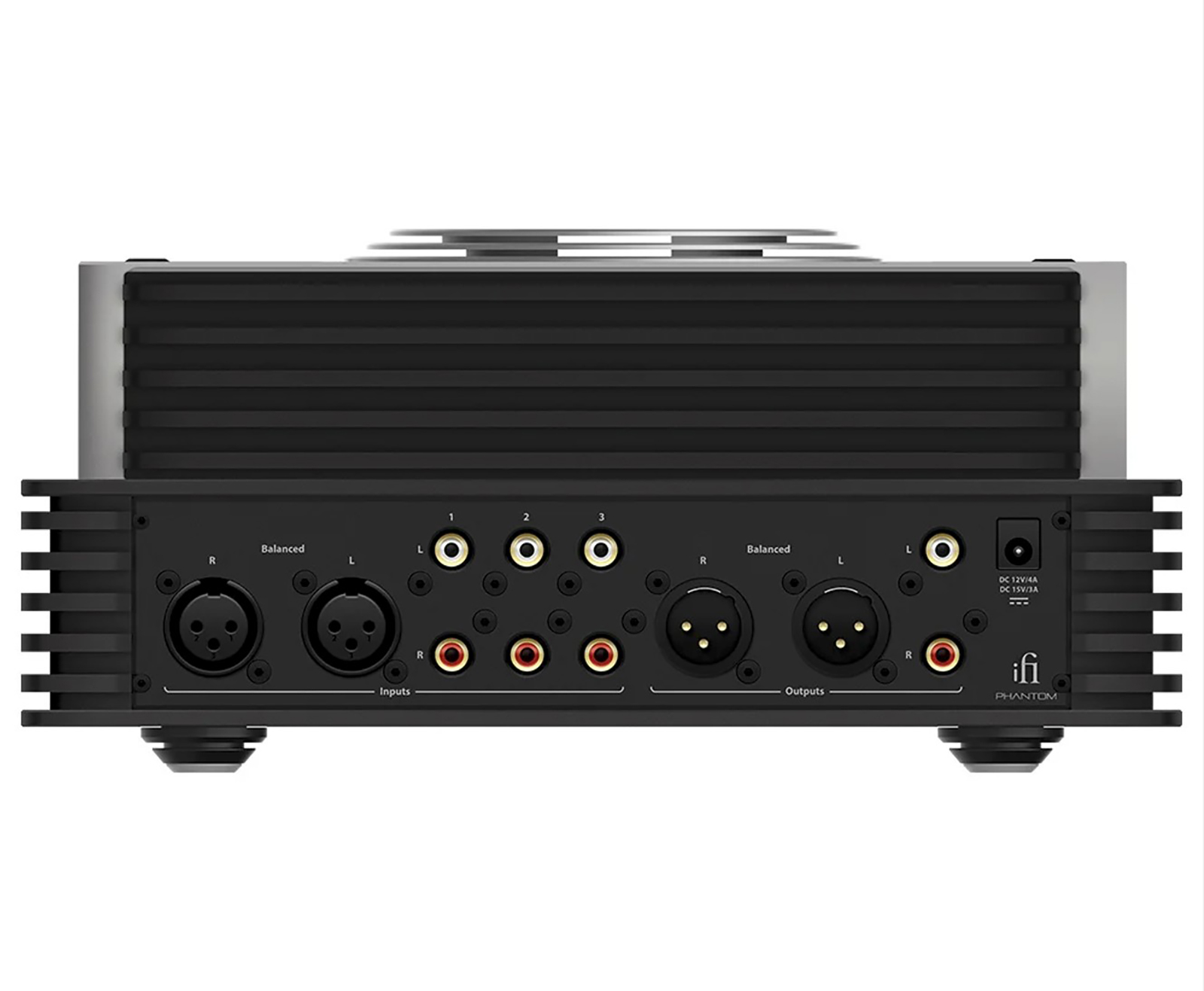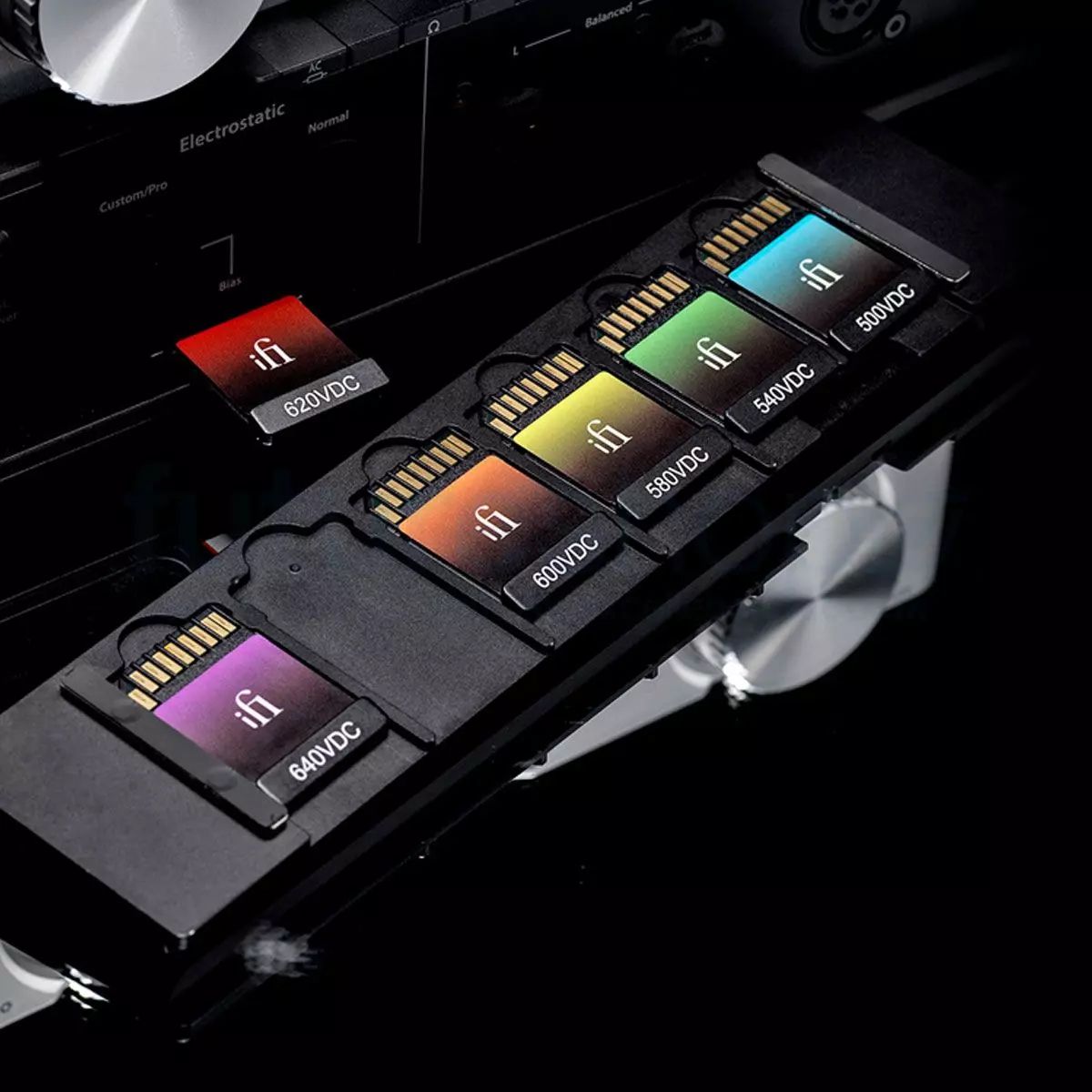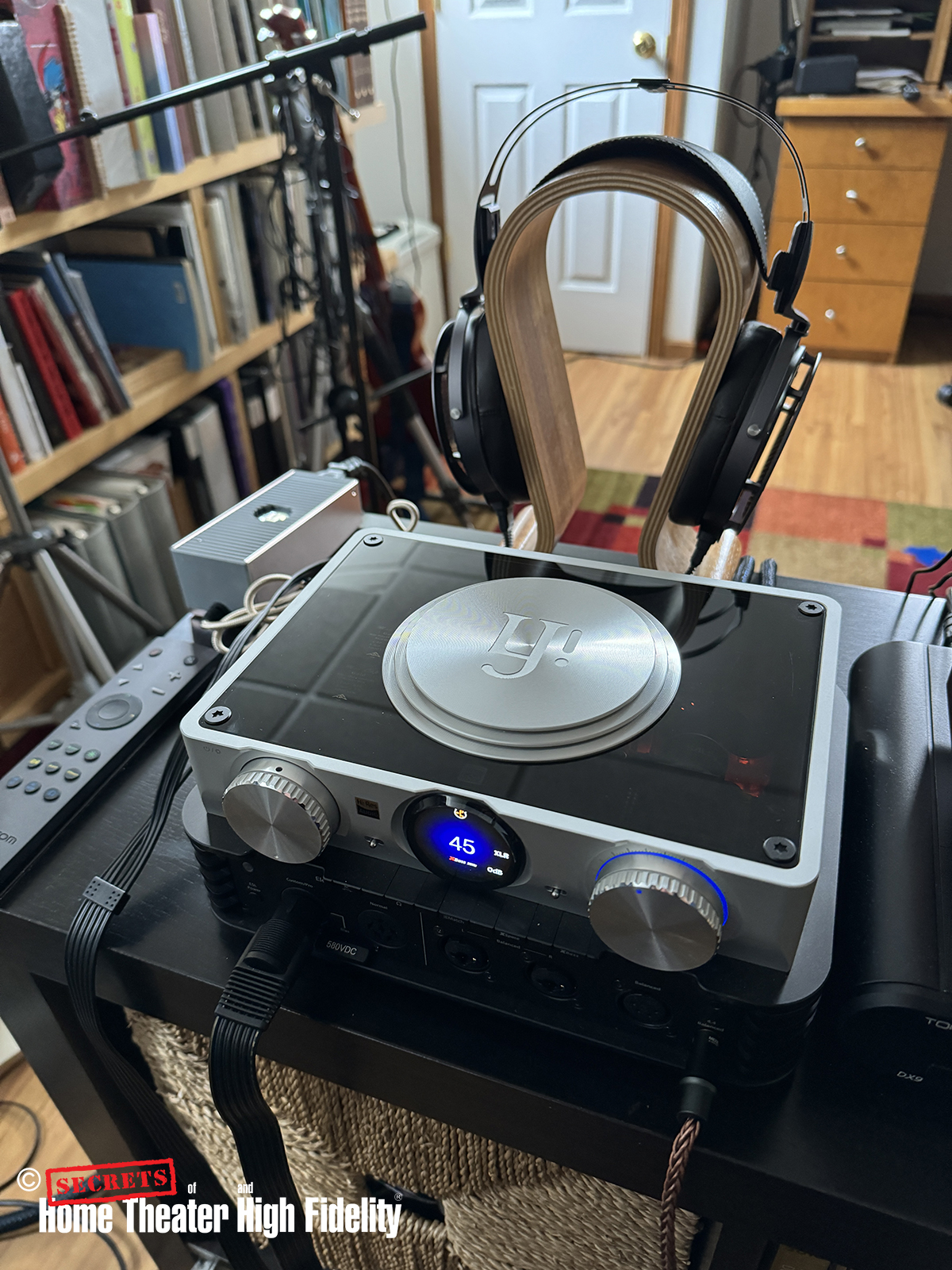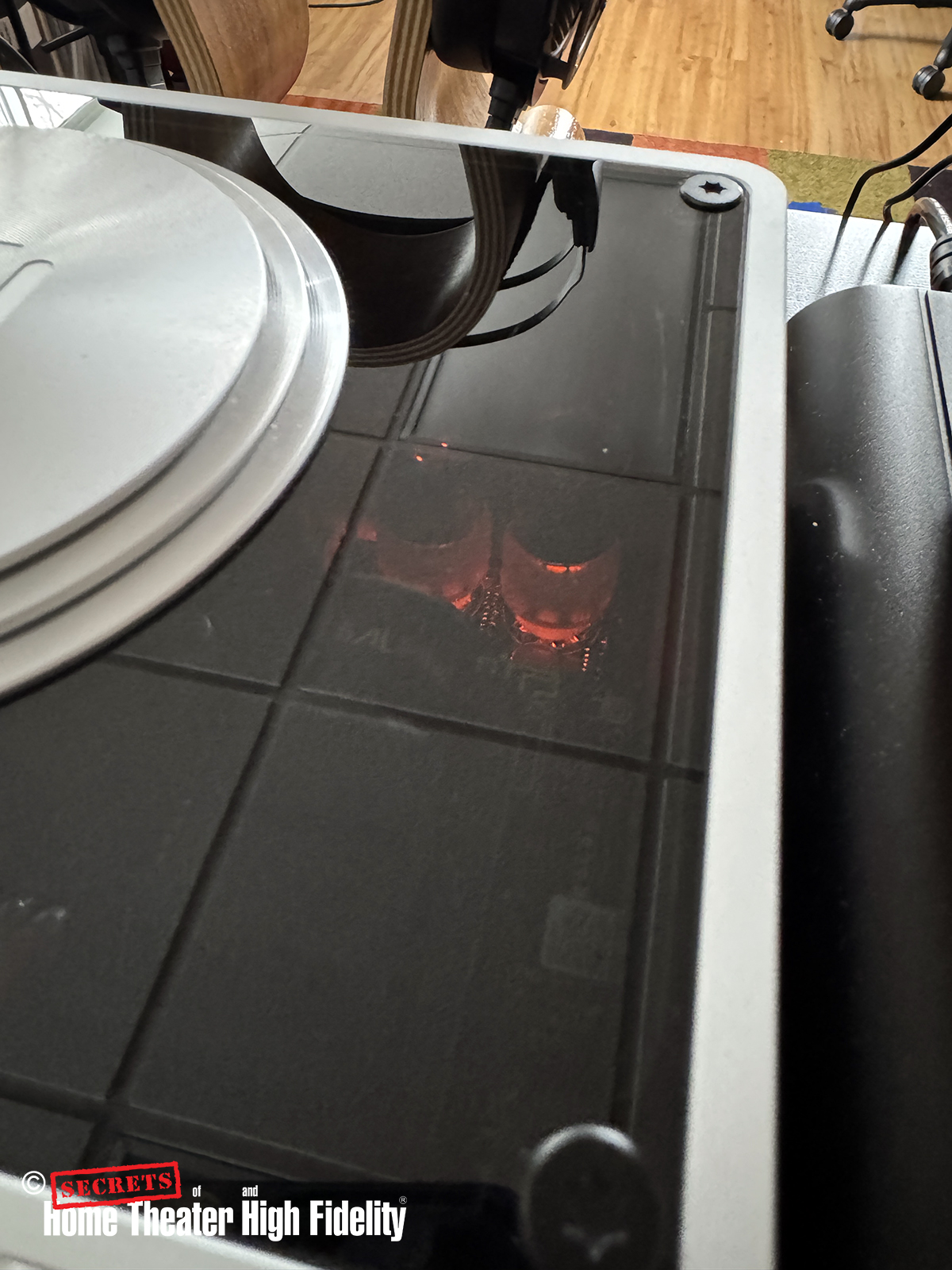The iFi Audio iCAN Phantom can essentially drive any type of headphone with any of the most commonly used terminations. Whether your listening whimsy calls for dynamic or electrostatic headgear, the iCAN Phantom can tango with both. Balanced or single-ended connections? Meh! Child’s play for this amplifier. Solid-state or tube drive? Take your pick. Can’t decide which of your half-dozen electrostatic headphones you want to listen to tonight? Why whichever one you want darling, since the iCAN Phantom’s output voltage can be biased to suit any of them. With the iCAN Phantom, iFi Audio is working overtime to prove that, if you have a bit of a headphone addiction, this amplifier is the only one you’ll ever need.
iFi Audio iCAN Phantom Headphone Amplifier
- Can drive either dynamic or electrostatic headphones from the same chassis.
- All types of balanced and single-ended connections are available.
- Electrostatic voltage bias is adjustable via a novel set of SD memory cards.
- Selectable solid-state or tube input stages for different sound signatures.
- Fully balanced amplifier design.
- Can also be used as a stereo preamp to drive a separate power amplifier connected to speakers.
Headphones are wonderful things. They come in all manner of types and designs to suit any listening, desire, taste, or environment. Most normal people have one, possibly two pairs of headphones or a headphone and an IEM and that’s more than enough for them. A true headphone fan or aficionado on the other hand is an obsessive individual potentially owning multiple sets of headphones of different types, for different uses, different music styles, and even different moods. Open-back, closed-back, planar magnetic, dynamic driver, sensitive IEM, electrostatic earspeaker, and so on. Each type has its own personality and allure and, before you know it, and without much effort, a music lover may find themselves with a bit of a collection on their hands.
Not speaking through personal experience (Cough! Cough!) but I digress. And if you have a bunch of headphones at your disposal, you surely need an amplifier to drive them to their fullest potential. As a previously categorized obsessive, you could purchase a reliable precision solid-state amp. Or maybe a warm, liquid smooth tube amp is more your speed. Wait, what about your electrostatic headphones? You’ll need a different amp altogether for those. What about those extra-sensitive IEMs? You’ll need a very low distortion amp to drive those noiselessly. What’s an obsessive listener to do? The iFi Audio iCAN Phantom is here to streamline your amp choices so regardless of what cans you want to listen to at any given moment, you are uniquely covered.
Design:
Combination dynamic and electrostatic headphone amplifier/preamplifier.
ESL Output Voltage:
Custom/Pro- 640V RMS max.
Normal – 320V RMS max.
Frequency Response:
0.5Hz to 500kHz(-3dB)
Gain:
0dB, 9dB and 18dB, user-selectable
Input Voltage:
DC 12V/4A or 15V/3A (Phantom iCAN)
Maximum Output Power:
Balanced: >15,000mW (@ 16Ω)
Unbalanced: >5,760mW (@ 16Ω)
Maximum Output Voltage:
Balanced: >27.0V (@ 600Ω)
Unbalanced: >14.0V (@600Ω)
RMS Output Power:
Balanced: >9,030mW (@ 32Ω)
Unbalanced: >3,120mW (@ 32Ω)
SNR:
Balanced: >145dB(A)
Unbalanced: > 130dB(A)
THD+N: Solid state
Balanced: ≤0.0015%
Unbalanced: ≤0.007%
Tube
Balanced: ≤0.002%
Unbalanced: ≤0.006%
Tube plus
Balanced: ≤0.012%
Unbalanced: ≤0.2%
Dimensions:
256 × 185 × 120 mm (10.1″ x 7.3″ × 4.7″)
Net Weight:
4.2 kg (9.3 Ibs.)
Accessories:
Remote Control, 1 x Pair RCA Cable, 1 x External Power Supply.
MSRP:
$3,749.00
Website:
Company:
SECRETS Tags:
ifi, headphone amplifier, electrostatic, tubes, solid-state
Secrets Sponsor
From an aesthetic standpoint, the iFi iCAN Phantom looks like nothing else out there. Beyond looking like it could be a small reactor or that it requires launch codes to get it going, it’s a generally awesome-looking piece of gear. The upper (silver) half of the unit is where all the control functions reside while the lower (black) half is home to all the connection interfaces. Setting eyes on the front of the iCAN Phantom, two rotary knobs and a centralized TFT display, flanked by two 3-position toggle switches, are the user’s master controls. Just below these, integrated into the heat sink trim, are five function buttons that activate/deactivate/adjust the following features: AC Termination, Impedance Adjustment, iEMatch, XSpace, and XBass.
The left rotary knob powers the unit on and off along with entering the menu system via a double-tap, after which you scroll and tap with the knob to make your choices and eventually exit the menu. The toggle switch immediately to the right adjusts the input stage mode from Solid-State, Tube, or Tube+ (Tube+ purportedly reduces the amount of negative feedback in the circuit allowing more of the tube’s character into the overall sound). Speaking of tubes, the iCAN Phantom comes with two NOS (New Old Stock) General Electric 5670 tubes pre-installed. When engaged, these can be seen in operation through the Phantom’s smoked glass top and can be easily replaced by the user if the need arises. The central display prominently shows the volume level with secondary indications of the Input type, Operation Mode, Bias Voltage, iEMatch, AC Termination, Volume, Impedance, XBass, XSpace, and Gain Settings. To the right of the display is the three- position gain switch, with settings of 0, +9, and +18 dB of gain respectively. To the right of this is the analog volume control knob.
The front controls and connections on the bottom half are (from left to right): Electrostatic amplifier power button, the variable bias ESL Headphone jack (works with variable bias SD cards inserted in the slot below the jacks), the standard bias ESL jack (230V), combination L and R 3-pin XLR/single-ended jacks, a 4-pin stereo XLR jack, a balanced 4.4 mm jack, and a 3.5 mm single-ended jack.
The back side of the iCAN Phantom is configured like a healthy analog preamp, with one pair of balanced XLR inputs, three pairs of single-ended RCA inputs, one pair of XLR outputs, and one pair of RCA outputs. Farthest to the right is the DC power supply input. Above the inputs is a removable panel that holds the 6 variable bias SD cards.
From a circuit design standpoint, iCAN Phantom has a fully differential balanced signal path. Feature-wise it incorporates many of the audio technologies that iFi is known for, such as adjustable XBass (analog bass signal processing), adjustable XSpace (holographic analog spatial processing), and iEMatch (setting reduces output level and background noise for sensitive IEMs).
The variable bias voltage SD cards for use with electrostatic headphones opens up this amplifier’s flexibility, further ensuring it can optimally drive any current and past electrostatic earspeaker you may want to pair with it. There are six cards to choose from and they affect the bias voltage on the left “Pro/Custom” bias electrostatic headphone output port. The SD card values along with the corresponding headphones are as follows:
500VDC – Sennheiser Orpheus HE-90, Monoprice Monolith Electrostatic
540VDC – Sennheiser HE-60, King Sound KS-H2/3/4
580VDC – Stax Pro Bias ESHP, Audeze crbn, Nectar HiveX, Muamp, VOCE
600VDC – Koss ESP/950 & DROP Koss ESP/95X, Jade
620VDC – HIFIMAN Shangri-La/La jr/Jade 2
640VDC – Sennheiser HE 1, HIFIMAN Shangri-La/La jr/Jade 2, Phenomenon Libratum/Canorum
The iCAN Phantom also connects with iFi’s NEXIS smartphone app allowing wide-ranging control of the Phantom from your iOS or Android device. Use of the NEXIS app is optional as the iCAN Phantom comes with a dedicated infrared remote control for added convenience.
Other accessories included are a pair of RCA cables and a dedicated external power supply.
While in my home for review, the iFi iCAN Phantom was connected to the balanced analog outputs of either my Topping DX9 headphone amp/DAC or the Geshelli Labs J2 DAC with Sparkos Labs Opamps. The DACs were connected via USB to my Microsoft Surface 3 PRO tablet (in its desktop dock) which acts as my Roon Core and manages my Qobuz account as well as my local library of digital music. The dynamic headphones used in this review included the Meze Audio 109PRO and Lyric II, the HIFIMAN HE1000v2, the Dan Clark Audio Aeon 2 Noire, the Beyerdynamic DT880 PRO, and the T5p Gen 2. The electrostatic headphones that were in the house at the time were my trusty STAX SR-L700 and the STAX SR-X9000 earspeakers.
I suppose it wouldn’t be enough to say that the iFi iCAN Phantom looks “really cool” and works “really well,” and just call it a day, would it? Describing the sound of amplifiers, whether for headphones or loudspeakers, is a bit more challenging than describing how speakers or headphones sound. An amplifier either has enough power, or it doesn’t. Is its noise floor audible, or isn’t it? And it’s either built well or the construction is lacking. Yes, if it has tubes in it then that throws a little variety into the mix regarding the sound signature. But, by and large, most modern amplifiers are generally very good with some mediocre ones out there that are only suited for very narrow use cases. The iCAN Phantom is VERY good, and I found its sound quality to be without fault. But what sets it apart is its sheer flexibility and feature set. I have not encountered any other headphone amplifier quite like it. The fact that it will drive both dynamic and electrostatic headphones just scratches the surface of what it can do.
Starting with how it drives dynamic headphones, it does that brilliantly. With the three different gain settings at hand, the iCAN Phantom had no issues driving any of the planar magnetic or dynamic driver headphones that I had around. The hardest headphones to drive that I have are the Beyerdynamic DT880 PRO. With a 250 Ohm impedance and a rated sensitivity of 96 dB, I find that they need a fair bit of juice to sound good, let alone generate any sort of bass. With the iCAN Phantom’s gain setting set to High (+18 dB) the DT880 PRO was singing quite nicely with plenty of headroom and more noticeable bass impact. I typically don’t like using audio processing or boost features with headphones but the iFi XBoost system, set to the 20 Hz position, gave some appreciated additional lower-end grunt to these headphones. Through the iCAN Phantom, I got to enjoy some extended listening sessions with the DT880 PRO for the first time in a good while.

ZZ Top, “RAW (‘That Little Ol’ Band From Texas’ Original Soundtrack)”
Listening to something like “Tube Snake Boogie” from ZZ Top’s RAW Soundtrack would sound tragically bass-anemic with these Beyers under normal circumstances. Not so with the iCAN Phantom. Frank Beard’s drum kit now had all the impact it was previously missing without the bass becoming overdriven or distorted. The late Dusty Hill’s bass lines and Billy Gibbons’ “crunchy” guitar sound had just the right sense of weight and depth while maintaining the rest of the headphone’s natural balance through the mids and highs.
For most dynamic and planar headphones that I paired with the iFi iCAN Phantom, I preferred having the amplifier’s input stage set to Solid-State Mode. I found that I enjoyed the clarity, transparency, and lack of noise afforded me with most headphones in this setting. It allowed me to best judge the sonic characteristics of each headphone I plugged in, regardless of connection, without the Phantom adding any flavor of its own. I find the Meze 109 PRO and Beyerdynamic T5p Gen 2 have a naturally warm bias to their sound and the Solid-State drive was an excellent match with them for my tastes.

Daniele Cordisco and Ron Carter, “Bitter Head”
“Canadian Sunset” from the album Bitter Head by bassist Ron Carter and guitarist Daniele Cordisco had a great sense of atmosphere and went perfectly with the natural tuning of these headphones. Solid-State mode letting those characteristics shine through unblemished.
Conversely, this changed for me though when I plugged in my HIFIMAN HE1000v2. Solid-State mode sounded great, but I found I really enjoyed these headphones more with the Tube Mode engaged. It added just enough warmth to its drive that it made music, especially classical tracks, sound smoother in the treble and just a touch fuller in the midrange.

Jerry Goldsmith, “Star Trek: The Motion Picture – The Director’s Edition (Music from the Motion Picture)”
Listening to “The Enterprise” from the Star Trek: The Motion Picture, the Director’s Edition Soundtrack sounded exquisite through its combination. This expansive, bombastic track never got abrasive when the full strings and brass sections kicked in. I just kept wanting to turn it up louder and get fully immersed in it. I could easily take or leave the Tube setting with my other headphones but with the HE1000v2 in particular, the sound signature made for a very nice match. The Phantom’s Tube+ Mode added a little too much “tube-ness” to the sound for me. I found it fun to experiment with short stints on various headphones, but its effect didn’t appeal to me for more than a track or two. Others may feel different and find the extra warmth to their liking. That’s part of the beauty of the iCAN Phantom, it gives you choices.
I had a similar feeling when experimenting with the iFi X-Space adjustment. I understand that it is not exactly a crossfeed circuit that is available in some headphone amps and computer playback software. But the desired result is essentially the same, to “decentralize” the sonic impression caused by headphone listening and recreate more of an impression of loudspeaker listening. Some listeners really like the crossfeed effect when listening to headphones, and the 4 different settings of XSpace (Off, 30 ̊, 60 ̊, and 90 ̊) do indeed expand the image and somewhat get it out of the center of your head. I’m less of a fan of this sort of processing because I like the sound of headphones precisely because they DON’T image like loudspeakers. So, while it works, and was fun to play with, I mostly left it off for any serious listening. It should be noted that the Solid-State/Tube input stage settings, XBass, and XSpace feature will also work on loudspeakers if the iFi iCAN Phantom is used as a traditional analog preamp which is another bonus. I did not use it in this way so I can’t comment on the effect these features will have when used in a traditional stereo setup. The user manual urges caution when using these features in that scenario and I would concur with that advice.
Things continue to get interesting when you press the Electrostatic ON button at the bottom left of the unit and the iCAN Phantom switches from a traditional headphone amplifier to an Electrostatic energizer. Before pushing said button though, I made sure I selected the 580V bias voltage SD card for STAX earspeakers and inserted it in the front slot, just below the 5-pin connector jacks. All the iFi “X-features” will also work on electrostatic headphones so you can experiment to your heart’s content. I personally set the input stage to Tube mode, the Impedance setting to 96-ohm, and began listening with my STAX SR-L700 Lambdas. The overall experience was exceptional. The Phantom had plenty of power to drive my old Lambda cans and extract all the lovely, effortless sound out of them that I could ask for. I’ve always found the SR-L700 to have a more than respectable bottom end when it comes to electrostatics, and the iCAN Phantom very much delivered the goods in those lower registers. Using the Tube mode option gave the STAX SR-L700 just enough of that extra warmth and smoothness which makes everything sound more appealing. From a sound quality standpoint, I think the Phantom compares favorably with STAX’s 700 series of energizers.
Switching to the STAX SR-X9000 headphones was like opening a window to a new sonic world. The iCAN Phantom was more than up to the challenge of driving the STAX flagship earspeakers, with plenty of power and headroom to spare. Again, favoring Tube mode for these headphones as well, the combination of iCAN Phantom and SR-X9000 was pretty much ideal.

Steely Dan, “Two Against Nature”
Cueing up Steely Dan’s “Cousin Dupree” from the Two Against Nature album was a delight. This track has it all, a tight funky groove, great bass, well-recorded vocals, and tasty guitar solos. The sense of transparency, tonality, and effortless dynamics that I was hearing was everything I could have expected from this pairing, with Tube mode adding just that hint of warmth that suited the STAX so well.
Secrets Sponsor
If you are looking for a headphone amplifier that does it all and with every possible type of headphone, then the iCAN Phantom could be your one-stop-shop for sonic happiness.
- Will drive both dynamic and electrostatic headphones.
- Novel SD card system for selecting electrostatic bias voltages.
- Choice of Solid-State or Tube input stage.
- It has every headphone connection under the sun.
- XBass, XSpace, and iEMatch are among the many available tweaks.
- Nothing of Consequence.
In some ways, the iFi iCAN Phantom is probably overkill for most headphone listeners. The full array of headphone connections, the ability to drive both dynamic and electrostatic cans (ANY electrostatic cans), the choice of solid-state or two types of tube drive, along with the various processing and setting options to play with makes this a drive unit for the truly committed headphone enthusiast. Someone who appreciates the inherent differences in various headphones of all types. Enough that they already own several sets of cans or plan to build a collection. The iFi iCAN Phantom can accommodate them all, drive them to their full potential, and be either a clean sheet of sonic glass or a tweaker’s delight. The choice is yours. On second thought, maybe the iCAN Phantom IS for everybody after all! Recommended!


